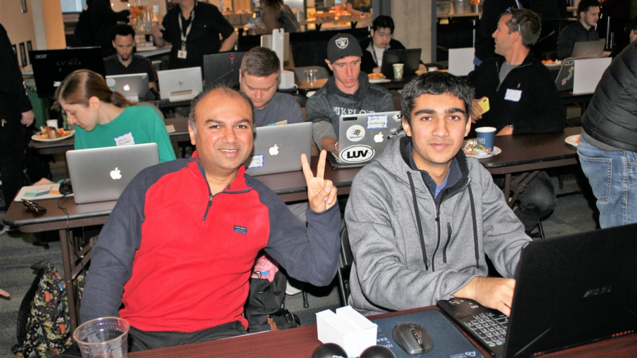
Building on Algorand: Developer Week 2020 Hackathon, Recap and Code
Over 600 attendees participated recently at the Algorand Sponsored Developer Week 2020 in San Francisco. It was a great mix of professional developers and students. First place went to XCarbon, a father and son team, Kaushik, and Soham Ashodiya! They delivered an outstanding presentation which can be viewed below. It was very well organized and the solution has great promise. The solution they provided, was for Carbon detection in large cities. The data would be captured by iOT devices, and stored on the Algorand Blockchain. It provides an immutable ledger so the data can not be tampered with. Algorand Standard Assets and Atomic Transfers were part of the solution. Second place went to team, GretaFoodBot. They had a great solution to help folks that need a meal and connects them to restaurants that were getting rid of excess, but edible, food. Great job for humanity. Team members are: Artur Markov and Anatoli Padenko.
First and Second place teams at Developer Week 2020 Hackathon, San Francisco, CA

Left to right: Russ Fustino (Algorand Inc) Fabrice Benhamouda (Algorand Foundation), Second Place Team GretaFoodBot: Artur Markov and Anatoli Padenko, First Place Team XCarbon: (Son and Father) Soham Ashodiya, Kaushik Ashodiya, and Algorand’s Sam Abbassi.
First Place: XCarbon


Description
City of New York is calling all the citizens to participate in a one of a kind, innovative project to reduce carbon footprint. This amazing project is a grass-root, bottom-up collaboration between Government and citizens for mutual benefits and for making the Earth safe place to our future generations!
Why do we need the help of the public?
Government alone cannot solve this problem. A massive problem needs to be solved by the masses. We cannot make progress on an issue that has not garnered public awareness. Through attaching IoT devices to public vehicles, we can increase the reach and mobility of the monitoring process.
Smart use of Internet of Things
Portable, mobile IoT devices that measure carbon. IoT devices can be produced in bulk, bringing down costs for the gov. These devices can be directly sold to the public to further relieve the cost burdens.
Most Effective Way to Measure Carbon Footprint
More sensors (high density of devices per meter) more accurate the measurements. Taking care of the IoT device is the end user’s responsibility, reducing the need for government maintenance crews. Raw data is immediately published for public access (currently, NYC releases data after 5 to 6 months).
Why Blockchain?
Can prevent tampering or inaccuracy of data metrics NYC officials could alter data to avoid costs. Traceability A small group of malicious IoT devices would not make a great impact. Openness Anyone can view the data; there is no reliance on NYC. Global reach
Plans for future
Higher rewards for user that can reach remote or obscure places. Use Algorand smart contracts to support features like: Lottery system Getting public votes on carbon policy decisions Measure additional pollutants like particulate matter, black carbon, etc. Can also measure additional metrics like temperature, humidity, etc.
Members: Soham Ashodiya, Kaushik Ashodiya
Devpost: https://devpost.com/software/xcarbon
Github Repo: https://github.com/soham1/dwhack2020-xcarbon

Second Place: GretaFoodBot
Description
We were inspired by a challenge of helping people to get free food and for restaurants — to optimize a food waste.
Restaurants owners may drop food for specific locations and receive Algorand token reward (+1 to karma) via the web app.
A regular user may search in telegram bot @GretaFoodBot for food nearby to find some food.
Members: Anatolii Padenko, Artur Mark
GitHub: https://github.com/Archivaldi/greta-food-bot
DevPost: https://devpost.com/software/gretafoodbot

